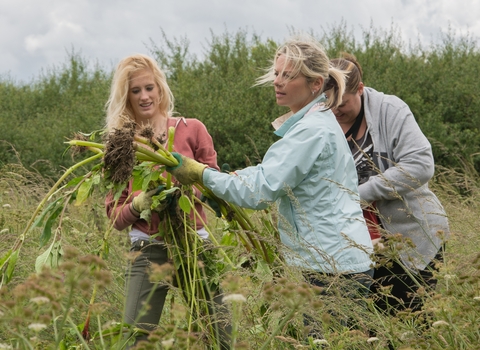Himalayan balsam © Lianne de Mello
Tackling Invasives
Around 10,000 years ago, a land bridge connected Britain to what is now mainland Europe. The end of the Ice Age allowed wildlife to colonise this newly habitable space, until rising sea levels formed the English Channel. All the plants and animals that were present in Britain at this point are classified as native species.
Non-native species, by contrast, are those transported outside their natural range by human activity. This isn't always a bad thing - the little owl is a deliberate transplant from Europe and the apple tree comes from Kazakhstan, but neither poses a problem for native wildlife.
When a species negatively impacts the environment, the economy, or human health, however, then it's classified as invasive. This impact can take many forms: invasive species might hunt native ones, or out-compete them for food and habitat. They might carry new diseases or have the ability to hybridise.
We're addressing this issue through the Tackling Invasives project, which is part of the Watercress and Winterbournes Landscape Partnership Scheme. The project is working to raise awareness about these species and stop them from spreading across the scheme area.

The Southern Co-operative volunteering day
Our work
It can be tempting to demonise invasive species, but it's important to remember that they were brought to Britain by human activity. In a way, these species are a victim of their own success: they're usually tough, adaptable opportunists with a talent for fast reproduction. These qualities allow them to survive in their natural ranges, but can severely unbalance other ecosystems.
Because of their detrimental impact, the UK's invasive species are often subject to control measures. There may be restrictions on importing, trading, and owning them. There may also be efforts to remove them, or to stop them from spreading further. These activities can be hazardous or counterintuitive if not done properly, so please seek expert advice before attempting them.
We're working to curb the spread of several invasive species within our scheme area. Our volunteers regularly remove invasive plants, and also use footprint rafts to monitor American mink. Could you join us?

Waders and fishing rod © Spartika via Getty Images
How to help
Some species can survive long periods out of water, and may be hitching a ride on your damp clothes or equipment. Follow the 'Check, Clean, Dry' process to avoid spreading plants, animals, and eggs.
Plants are natural escape artists, and we don't know which ones could become invasive in the future. Try to fill your outdoor space with local species, or take steps to stop non-native ones from 'jumping the fence'.
Sightings of invasive species are an invaluable tool for controlling their spread . There are several websites and apps for recording sightings, even if you're not completely sure what species you've seen.





